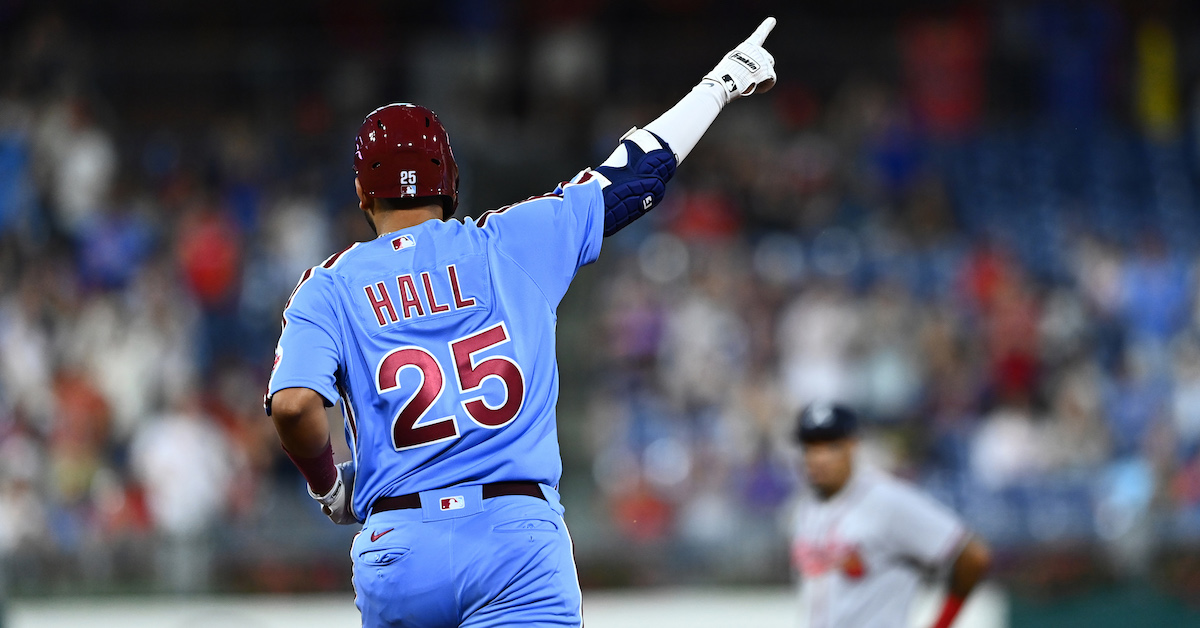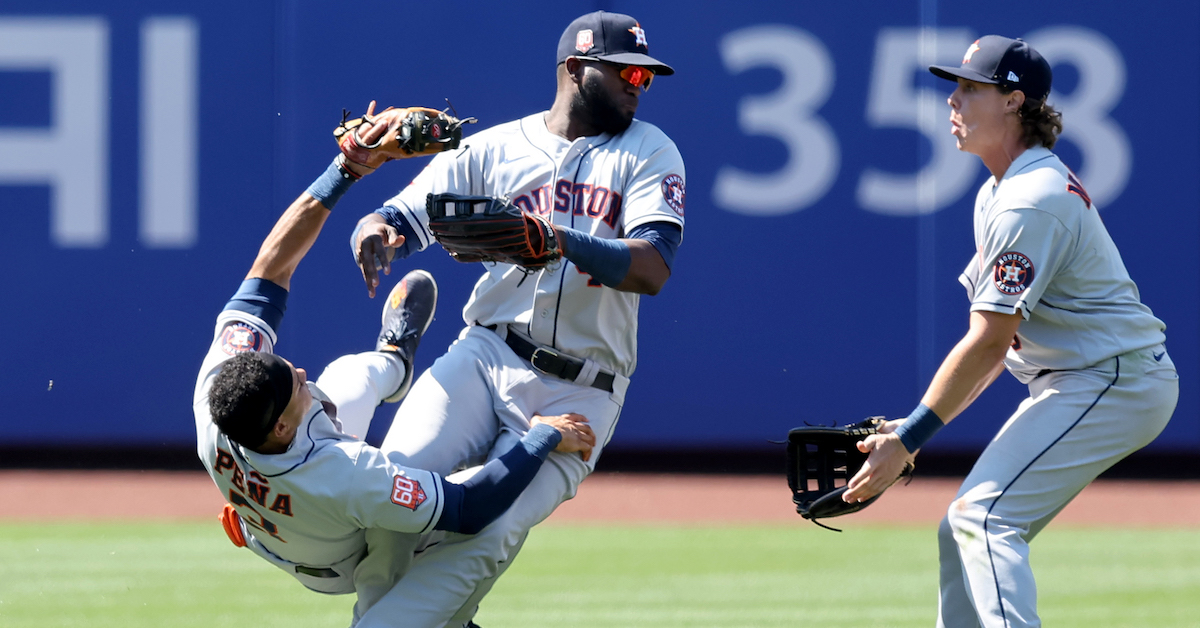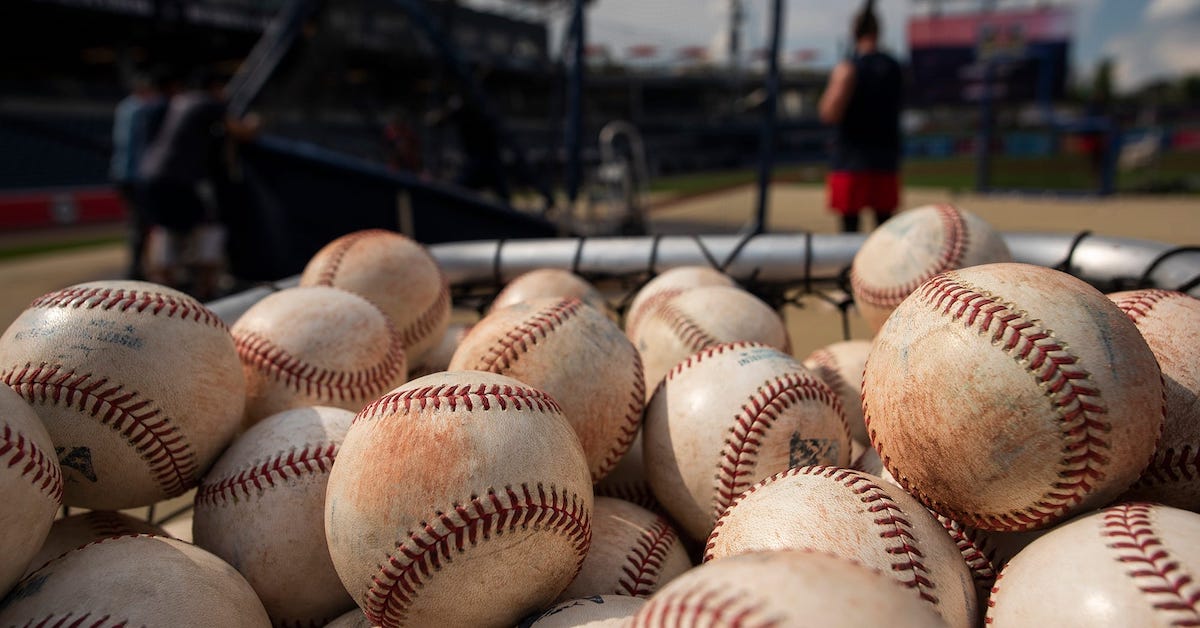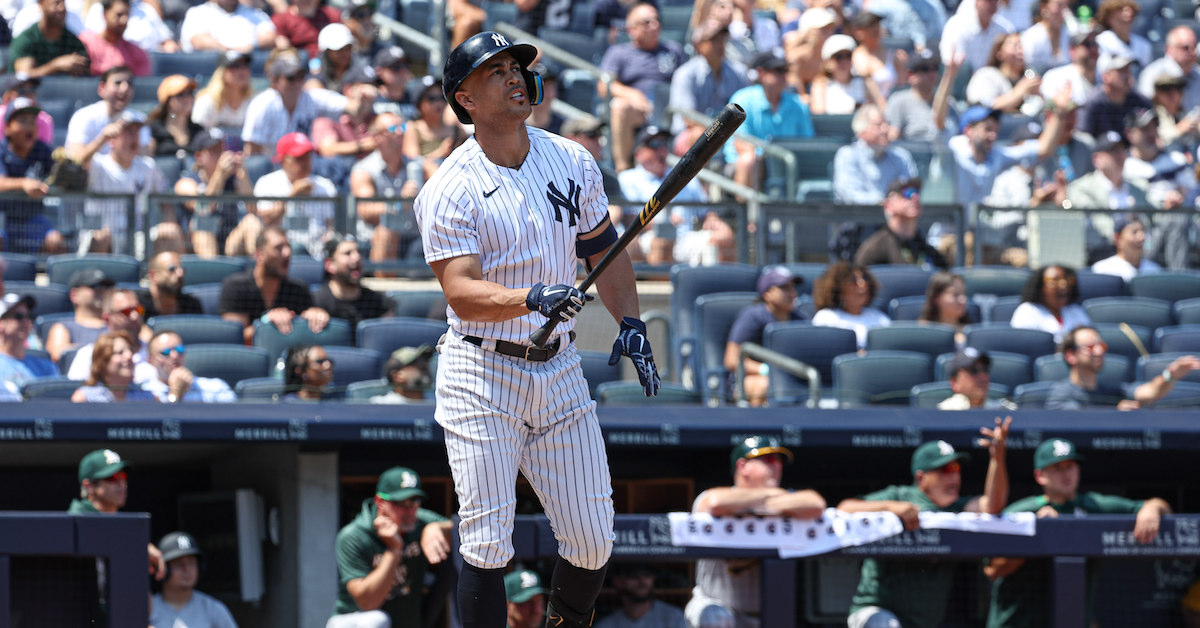Kyle Garlick was a long shot to make the big leagues when he was first featured here at FanGraphs in 2016. A 28th-round senior-sign by the Los Angeles Dodgers the previous summer, Garlick was 24 years old, unranked, and very much under the radar. Moreover, he was heading into an offseason where he’d be working two jobs to help make ends meet. As Garlick explained at the time, he was going to be working half days on a construction crew, and bar-backing at a restaurant on weekends.
Six years later, he is a valuable role player on a contending team. In 81 plate appearances with the Minnesota Twins, the right-handed-hitting outfielder is slashing .274/.333/.534 with six home runs and a 145 wRC+.
There have been a lot of ups and downs along the way. Since debuting with the Dodgers in 2019, Garlick has been traded once, claimed off of waivers twice, and spent multiple stints on the injured list and in Triple-A. That his MLB resume consists of 111 games over parts of four seasons qualifies as an accomplishment.
Earlier this season, I asked Garlick about his expectations at the time of our 2016 conversation. Did he truly see himself reaching the big leagues?
“Personally, I was very sure,” responded Garlick. “I don’t know that others were. But even though I had faith in myself, I had backup plans. When I went back to Triple-A in 2019. my thought was that if I didn’t get called up that year, I would give myself 2020. If I didn’t get called up then, I was probably going to hang it up. Luckily that didn’t happen. I got called up [in 2019] and that changed my life. I’ve been able to make myself a little career out of baseball.”
Garlick earned a degree in General Social Science from the University of Oregon, but his backup plan had no connection to his studies. He was going to become a firefighter.
“I had a few buddies doing that, and they loved it,” explained Garlick. “It’s kind of a clubhouse vibe, and I’d have been doing things like saving lives. I couldn’t see myself in a desk job, sitting behind a screen, and that’s something that appealed to me.”
Not so much anymore. Garlick celebrated his 30th birthday this past winter, and while he can still square up high heaters, fighting flames is another story
“I’m getting older,” Garlick reasoned. “I don’t know how many guys start firefighting when they’re my age, but it’s probably not too many. So, I’m not sure what comes next. I kind of put all of my eggs in one basket for baseball when I chose a college major. Maybe I’ll stay in the game in some capacity. I’ll figure that out when the time comes.”
———
RANDOM HITTER-PITCHER MATCHUPS
Tom Prince went 3 for 5 against Jeremy Affeldt.
Jeff King went 5 for 8 against Rick Aguilera.
Dave Kingman went 6 for 9 against Matt Young.
Jimmy Outlaw went 6 for 9 against Mel Queen Sr.
Roberto Clemente went 6 for 12 against Mel Queen Jr.
———
Dan Dickerson wasn’t one of the contributors to Broadcaster’s View: What is the Best Pitching Performance You’ve Seen? when the piece ran here at FanGraphs on June 2nd. Better late than never, the radio play-by-play voice of the Detroit Tigers shared the following when I caught up to him at Fenway Park a few weeks ago.
“My No. 1 would be Kenny Rogers against the Yankees, Game Three of the 2006 ALDS,” Dickerson told me, adding that the southpaw’s career ERA against the Bronx Bombers was well north of six. “That lineup was loaded. As Jim Leyland called it, it was ‘Murderer’s Row, and then Cano.’ Robinson Canó was hitting ninth.
“He went out there and channeled young Kenny Rogers, at 41 years old,” continued Dickerson. “I don’t know what the radar gun said — I’m not even sure there was a radar gun — but he was reaching back and firing fastballs. And he was so animated. He was feeding off the crowd and vice versa. When he left the mound, that place just erupted. I think he went seven-and-two-thirds, but whatever it was, he was incredible.”
Dickerson’s second and third choices were by the same pitcher.
“I’ve seen Justin Verlander’s no-hitters, but his back-to-back Game Fives in Oakland — almost exactly one year apart to the day — are the ones that stand out the most,” said Dickerson. “Two years in a row, the Tigers had to play a deciding Game Five in Oakland, and those crowds were the loudest I’ve heard in the postseason. That place was crazy. It was like a Raiders game.
“[Verlander’s] combined line for the two games was 17 innings, no runs, six hits, two walks, and 21 strikeouts. I mean, who do you want on the mound in a big game? The answer is Justin Verlander. Deciding games, and it was, ‘This is what I want, and this is what I’m going to do.’ Phenomenal.”
———
A quiz:
Dave Righetti completed his July 4, 1983 no-hitter by striking out that season’s American League batting champion. Who did the New York Yankees southpaw fan for the final out?
The answer can be found below.
———
NEWS NOTES
SABR has added a Baseball Broadcasting panel to its annual convention, which will be held in Baltimore from August 17-21. Kevin Brown, the TV play-by-play voice of the Orioles, and Joe Castiglione, the radio play-by-play voice of the Red Sox, will be the featured panelists.
Joe Staton, a first baseman for the Detroit Tigers for parts of the 1972 and 1973 seasons, died earlier this month at age 74. A Seattle native who went a combined 4 for 19 in his two cups of coffee, Staton had an RBI single in his final MLB plate appearance, then retired from baseball at age 25.
——-
The answer to the quiz is Boston’s Wade Boggs, who went on to finish the season with a .361 average and just 36 strikeouts in 685 plate appearances. Righetti fanned the Hall of Famer twice while pitching his July 4 gem.
———
Tyler Mahle was refreshingly honest when I asked him about his curveball prior to the 2020 season. Shortly before spring-training camps were shut down due to the emerging pandemic, the Cincinnati Reds right-hander told me that not only was the pitch a work-in-progress, “Technically, [he hadn’t] thrown a really good curveball yet.”
He had thrown some bad ones. In 2019, Mahle’s curveball usage was 23.1%, and his 3-12 won-lost record was accompanied by a 5.14 ERA. Aware that the pitch had been getting squared up all too often, he was hoping to remake it into an actual asset. Instead, he ended up scrapping it entirely. Mahre hasn’t thrown a curveball since our 27-months-ago conversation.
When I asked Mahle about that at the beginning of this month, he said the decision was based more on the quality of his slider than it was on the inability to develop a reliable hook. He also pointed to the continued improvement of his splitter, which he learned in 2018 after being sent back down to Triple-A. Taught to him by then-Louisville Bats pitching coach Jeff Fassero, it proved a panacea to his longtime struggles to effectively throw a conventional changeup.
Mahle has thrown his splitter 25.4% of the time this year while going 3-6 with a 4.53 and a 3.38 FIP. Last season he went 13-6 with a 3.75 and a 3.80 FIP.
———
FOREIGN AFFAIRS
Shogo Akiyama is returning to NPB, having reportedly agreed to a three-year deal with the Hiroshima Carp. The 34-year-old outfielder played for the Seibu Lions from 2011-2019 before spending the 2020 and 2021 campaigns with the Cincinnati Reds. Akiyama was with San Diego’s Triple-A affiliate earlier this season.
Kensuke Kondoh has been activated from the injured list by the Nippon-Ham Fighters. The 28-year-old, lft-handed-hitting outfielder has a .307/.410/.430 slash line over 11 NPB seasons.
Enny Romero is 6-4 with a 2.00 ERA over 72 innings for NPB’s Chiba Lotte Marines. The 31-year-old former MLB left-hander has been pitching in Japan since 2019.
Per MassLive’s Katie Morrison, Thomas Pannone has been granted his release by the Red Sox and will be taking his talents to the KBO. The 28-year-old former Toronto Blue Jays southpaw signed with Boston in March and has been pitching for Triple-A Worcester.
Yefry Ramírez allowed four runs over two-and-a-third innings in his first appearance with the Hanwha Eagles. The 28-year-old former big-league right-hander signed with the KBO club earlier this month.
———
Brayan Peña manages the West Michigan Whitecaps. He’s also a diehard fan of Real Madrid. In his second season at the helm of Detroit’s High-A affiliate, Peña has been supporting the legendary Spanish soccer club for most of his 40 years.
“When I grew up in Havana, Cuba, there were only two teams that you would root for, and that was Barcelona or Real Madrid,” Peña said of his fútbol allegiance. “My family loved Real Madrid. They loved the uniforms, everything. Mentally, we would picture Madrid — such a beautiful place — and I knew that I wanted to visit one day.”
That dream came true after Peña retired from a big-league playing career that spanned the 2005-2016 seasons. Traveling to Spain, he was able to purchase not only the Real Madrid jersey that hangs in his office, but also
tickets for a match at 81,000-seat Santiago Bernabéu Stadium.
“We had a chance to see Cristiano Ronaldo play, too” Peña said of the Portuguese superstar. “It was beautiful, man. It was one of my dreams, and it came true. God allowed me to be in that position with my wife and my kids. It was awesome.”
———
FARM NOTES
Jared Shuster has a 3.27 ERA over 14 starts comprising 71-and-two-thirds innings for the Double-A Mississippi Braves. The 23-year-old left-hander — No. 4 on our Atlanta Braves Top Prospects list — has allowed 57 hits, issued 19 walks, and logged 82 strikeouts.
Cole Ragans has a 2.50 ERA over 13 starts comprising 68-and-third innings between Double-A Frisco and Triple-A Round Rock. The 24-year-old left-hander — No. 20 on our Texas Rangers Top Prospects list — has allowed 54 hits, issued 22 walks, and logged 84 strikeouts.
Drew Parrish has a 3.13 ERA over 14 starts comprising 74-and-two-thirds innings between Double-A Northwest Arkansas and Triple-A Omaha. The 24-year-old left-hander — No. 17 on our Kansas City Royals Top Prospects list — has allowed 51 hits, issued 23 walks, and logged 60 strikeouts.
Emerson Hancock has a 3.03 ERA over eight starts comprising 29-and-two-thirds innings for the Double-A Arkansas Travelers. No. 6 on our Seattle Mariners Top Prospects list, the 23-year-old right-hander discussed his repertoire and early-career development here at FanGraphs last summer.
Peyton Battenfield has a 3.08 ERA over 16 starts comprising 90-and-two-thirds innings for the Triple-A Columbus Clippers. No. 25 on our Cleveland Guardians Top Prospects list, the 24-year-old right-hander was featured here at FanGraphs last August, a month after being traded to Cleveland by the Tampa Bay Rays.
———
LINKS YOU’LL LIKE
At Crawfish Boxes, Cody Poage wrote about Houston Astros reliever Enoli Paredes, for whom control is the key.
Purple Row’s Renee Dechert feels that Colorado Rockies fans deserve better, and she has opinions on how to make that happen.
Pitching coach Wes Johnson unexpectedly left the Minnesota Twins to assume that same role at Louisiana State University. Dan Hayes has the story at The Athletic (subscription required).
The Senate Judiciary Committee is questioning the legality of MLB’s antitrust exemption, and Joon Lee wrote about it for ESPN.
———
RANDOM FACTS AND STATS
Manny Machado, who turns 30 years old on July 6, has a .282 batting average, 1,510 hits, and 263 home runs. Ron Santo had a .281 batting average, 1,592 hits, and 253 home runs prior to turning 30.
The first year the Boston Red Sox hit more home runs than triples as a team was 1931. Last year the Red Sox hit 219 home runs and 23 triples. (Hat tip to historian Bill Nowlin for the fact.)
Thirty-two people born in the state of New Hampshire have pitched in at least one big-league game. Of them, Sam Fuld is the only one with a career ERA of 0.00. The erstwhile outfielder — now the general manager of the Philadelphia Phillies — faced one batter in 2013 while playing for the Tampa Bay Rays. Fuld retired JB Shuck on a fly ball.
In 1938, Philadelphia Athletics outfielder “Indian Bob” Johnson had 114 runs scored, 113 RBIs, and a .552 slugging percentage. In 1939, Johnson had 115 runs scored, 114 RBIs, and a .553 slugging percentage,
Chick Stahl had 72 walks and just 10 strikeouts when he slashed .351/.426/.493 for the National League’s Boston Beaneaters in 1899. Stahl was a 34-year-old player-manager for the Boston Americans when he died after drinking poison in 1907.
On today’s date in 1912, the New York Giants won their 15th and 16th games in a row by sweeping a double-header from the Brooklyn Dodgers. The John McGraw-managed club ran their record to 54-11 on the way to a 103-48-3 season.
On today’s date in 1966, Atlanta Braves pitcher Tony Cloninger helped his own cause with a pair of grand slams in a complete-game 17-3 win over the San Francisco Giants. The right-hander went 3 for 5 with nine RBIs on the day, while Hank Aaron, Rico Carty, and Joe Torre homered in support.
Luis Tiant had 19 strikeouts while tossing a 10-inning, 1-0 shutout over the Minnesota Twins on today’s date in 1968. The Cleveland righty finished the season 21-9 with a 1.60 ERA and nine shutouts.
Players born on today’s date include Bunny Brief, whose 256 home runs are the all-time record in the now-defunct American Association. The Remus, Michigan native also went deep five times over parts of four big-league seasons, with the last of his blasts coming with the Pittsburgh Pirates in 1917.
Eddie Rommel — born Edwin Americus Rommel, in Baltimore — became a longtime American League umpire following a playing career that saw him go 171-119 over 13 season with the Philadelphia A’s. Twice a 20-game winner, Rommel recorded the last of his wins on July 10, 1932, working 17 innings of relief in an 18-inning, 18-17 Philadelphia win over Cleveland.









